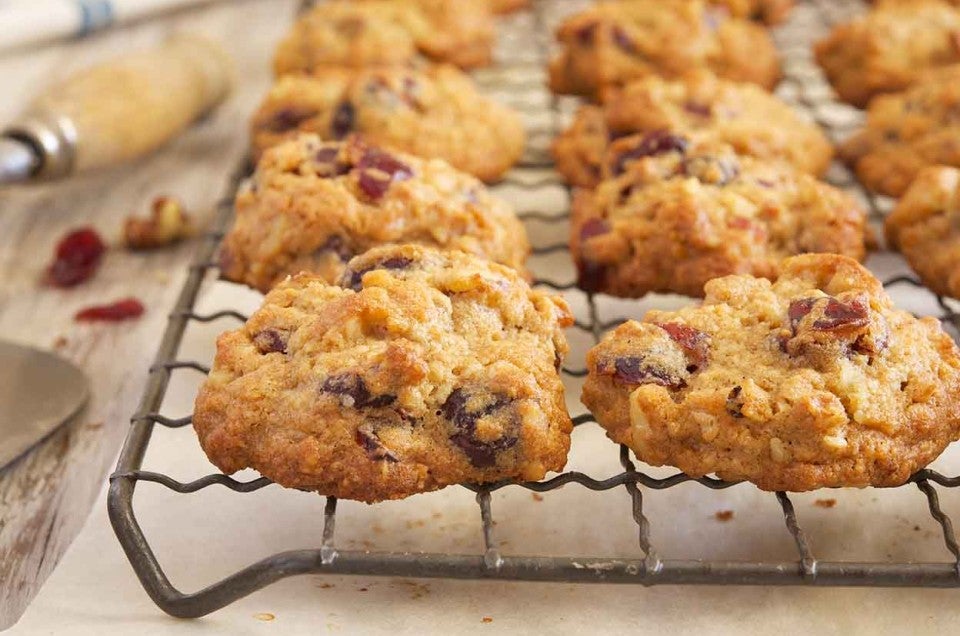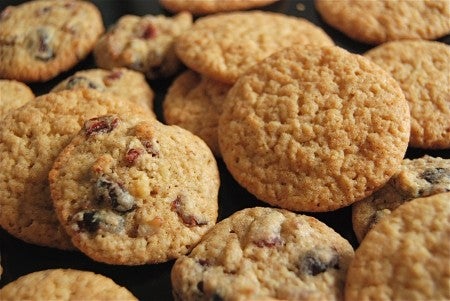


So, you think you don't like whole grains? Wait! Stay with me here. If whole wheat flour comes immediately to mind when you think "whole grains" -well, think again. These cookies prove that whole grains can be absolutely invisible in your baking.
The very easiest way to get your family to eat whole grains is via cookies. Do your kids like oatmeal cookies? Then you're halfway there, with the oats. Substitute whole wheat flour—golden wheat flour— for the all-purpose flour, and Bob's your uncle: 100% whole-grain cookies.
Still, some kids balk at cookies that don't LOOK exactly right. You know, cookies that have that weird, "Mom's trying to sneak something past me and I'm not buying it" look. If the chocolate chip cookie doesn't look like Chips Ahoy—forget it.
And then there are the discerning friends who have very specific preferences regarding spread. Most folks DON'T like cookies that are cake-like and puffy; they want the edges crisp, the center chewy. Not quite "puddle of dough with chips like islands," but more in that direction than cake-disguised-as-cookie.
How to satisfy all of these constituencies? It took days of experimenting, but by Arthur, I think we've got it! This 100% whole grain cookie has great taste, the perfect consistency, and the right "look."
I know many of you try to avoid vegetable shortening, even the trans-fat free variety. So I did some work here to make an all-butter cookie that could hold its shape. Well, truth be told, a LOT of work. I went far beyond my usual “three strikes and you're out” rule, and went through seven incarnations of this recipe before I found a version that was A), all butter; and B) spread nicely with the addition of chips, nuts, etc.; yet still held its shape without add-ins.
And then there were the experiments with ground oats vs. quick oats; refrigerated dough vs. room-temperature dough; plain cookies vs. cookies with added chips, nuts, etc.; and adding orange juice (to assist spread), or not. At this point I figured I'd bitten off nearly more than I could chew; though the chewing was indeed quite tasty.
Here's the difference between using quick oats (on the left) and ground oats (on the right). I'd use ground oats if I were really trying to disguise the whole-graininess of the cookie – like, if I was making chocolate chip cookies for kids. Otherwise, I'd skip the grinding and use quick oats, as is.
So I finally settled on a series of options: ground oats, no added juice, refrigerated dough for the most attractive "no add-ins" cookies. And quick oats, added juice, refrigerated dough for the best-looking, best-texture "add-ins" cookies. Don't try to memorize this; it won't be on the final exam. You'll see your options when you read the recipe.
Without further ado, let's make 100% whole grain cookies. If you want to read the recipe as you look at these photos, here it is: Basic Whole Grain Cookies.
So, I have to flog/blog my favorite flour yet again: King Arthur Golden Wheat Flour. Just what the bag says: lighter, milder, but still 100% whole wheat. Use in your cookies or bars or many muffins, you'll never know it's there. In yeast breads, this organic flour seems to give yeast a boost—maybe it's extra minerals? Not sure, but if you want to make 100% whole wheat bread, give this flour a try.
And if you want to make 100% whole grain cookies—and why not, if your family won't notice the difference—try our golden wheat.
Let's start with butter, brown and white sugars, vanilla, salt, baking powder, and baking soda.
Mix till smooth.
Add an egg...
...and mix till smooth again. Look how much difference a single egg makes.
Next, you get to choose: quick oats, for a somewhat chunkier cookie. Or ground oats, for a smoother, less obviously whole grain cookie. If you don't mind the chunky appearance, use quick oats, without grinding. Quick oats are traditional rolled oats that have been chopped a bit finer. If all you have is traditional (“old fashioned”) rolled oats, give them a quick whirl in a food processor to break them up a bit.
Now, if you want a really smooth cookie, take quick or traditional oats and give them a 30-second whirl in your food processor or blender. Alternative: use 3/4 cup oat flour. Why use ground oats or oat flour? Because it makes a smoother-textured cookie with an optimal amount of spread.
On the left, ground oats. On the right, golden wheat flour. Not a whole lotta difference, huh? At least in appearance. Ground oats have a delightfully sweet/nutty flavor; but they also contain no gluten at all, meaning they won't add much to the cookie's structure. That's the wheat's job.
I'm using parchment to pour the wheat and oats into the bowl. Parchment is my best friend in the kitchen.
Next, decide whether or not you'll be adding any fruit, chips, nuts, etc. to the cookie dough; your decision makes a difference going forward. No, not adding anything? Skip down a few photos. Yes, adding? Continue reading here.
I'm very partial to the dried cranberry/dark chocolate combo, so that's what's going into my mixing bowl here—along with some orange juice. And what, pray tell, is the OJ for? We've found, over years of whole wheat experiments, that orange juice tempers any possible tannic taste added by whole wheat. Don't worry, your cookies won't taste like orange; they'll simply taste mild, not assertively whole-wheaty.
And here's the next key step in assuring the correct spread: refrigerating the dough overnight. Here's the dough with fruit and chips; notice how wet it looks.
And here it is without add-ins. Into the fridge they both go. Refrigeration not only solidifies cookie dough, it adds another level of richness to the cookies' flavor. See our chocolate chip cookie post for more information on this.
Next day, the dough will be quite stiff. Drop it by teaspoonfuls (1” round balls) onto a parchment-lined (or lightly greased) baking sheet. A teaspoon cookie scoop works very well here. And why teaspoon-sized balls, rather than tablespoon? Well, a “teaspoonful” of dough, in its classic sense, is actually about 2 level teaspoons of dough. That size dough ball will spread into a 2 1/4” to 2 1/2” cookie.
Here's another mini-experiment: notice that some of the cookies I flattened, and some I didn't. Would it make a difference?
The answer is no—no need to flatten cookies. At this point I was holding my breath: would both types of cookie—with add-ins, and without—spread nicely?
Yes indeed. I didn't leave quite enough room between the non-chip cookies, but they spread to an optimal thickness.
And the chip/fruit version did just fine, too. The simple addition of 2 tablespoons liquid to the chip/fruit cookies ensured their spread.
Let's backtrack. These cookies are a great candidate for the freezer. Once you've deposited the dough onto the cookie sheet, place the cookies close together.
Cover with plastic wrap, and freeze. I actually used a quarter sheet pan here, as it takes up very little room in the freezer; and I covered it with an elasticized shower cap. Once the cookies are frozen (after a couple of hours), simply dump them into a sealable plastic bag. They'll store nicely for several months. When you're ready to bake, remove as many as you like, place (frozen) on a cookie sheet, and bake for a minute or so longer than the recipe calls for.

Take your pick: plain or fancy.
Cold milk is my preferred beverage – especially since I understand how vital calcium and vitamin D are for your health.
Read, bake, and review (please!) our recipe for Basic Whole Grain Cookies.

